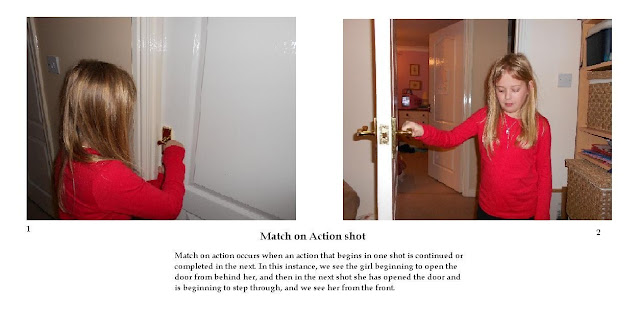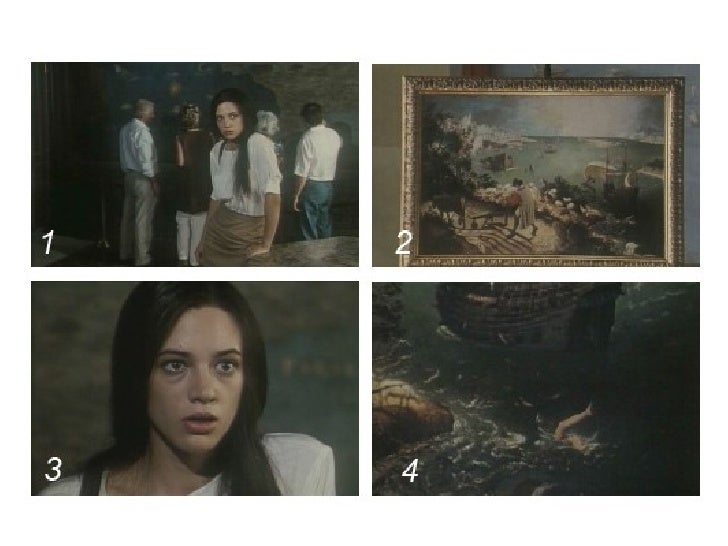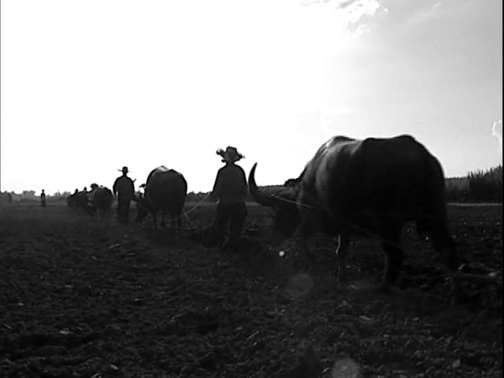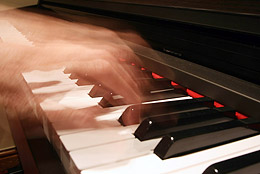
The 180° rule is a cinematography guideline that states that two characters in a scene should maintain the same left/right relationship to one another . When the camera passes over the invisible axis connecting the two subjects, it is called crossing the line and the shot becomes what is called a reverse angle.
Editing (post production)
Cutting:

Shot/reverse shot- is a film technique where one character is shown looking at another character (usually off-screen), then the other character is shown looking back at the first character.

Jump cut- editing in which two sequential shots of the same subject are taken from camera positions that vary only slightly. This type of edit gives the effect of jumping forwards in time.

Parallel editing- is the technique of alternating two or more scenes that often happen simultaneously but in different locations. If the scenes are simultaneous, they occasionally culminate in a single place, where the relevant parties confront each other.

Cutaway-is the interruption of a continuously filmed action by inserting a view of something else. It is usually, although not always, followed by a cut back to the first shot, when the cutaway avoids a jump cut.

Insert- is a shot of part of a scene as filmed from a different angle and/or focal length from the master shot. Inserts cover action already covered in the master shot, but emphasize a different aspect of that action due to the different framing.

Eyeline match- is a film editing techniquecommonly associated with continuity editing.Eyeline refers to the path of the lookingeye and is similar to the shot reverse.

Graphic match- is a cut in film editing between either two different objects, two different spaces, or two different compositions in which objects in the two shots graphically match, often helping to establish a strong continuity of action and linking the two.

Cross cutting- is an editing technique most often used in films to establish action occurring at the same time in two different locations. In a cross-cut, the camera will cut away from one action to another action, which can suggest the simultaneity of these two actions but this is not always the case.

Action match- refers to film editing and video editing techniques where the editor cuts from one shot to another view that matches the first shot's action.
Other transitions and pacing:
Dissolve- is a gradual transition from one image to another.
Fade-in- an image is made to appear gradually or the volume of sound is gradually increased from zero. Usually in the beginning of a clip.

Fade-out- is made to disappear gradually or the sound volume is gradually decreased to zero.

Wipe- an effect causing the transition from one scene to the next in which the image of the first scene appears to be wiped off the screen by that of the second.

Superimposition- is the placement of an image or video on top of an already-existing image or video, usually to add to the overall image effect, but also sometimes to conceal something (such as when a different face is superimposed over the original face in a photograph).

a long take or oner is an uninterrupted shot in a film which lasts much longer than the conventional editing pace either of the film itself or of films in general, usually lasting several minutes. Long takes are often accomplished through the use of a dolly shot or Steadicam shot.

Fast motion- action that appears to move faster than normal on the screen, accomplished by filming the action at less than normal speed in the camera and then projecting it at normal speed.
Ellipsis- the shortening of the plot duration of a film achieved by deliberately omitting intervals or sections of the narrative story or action; an ellipsis is marked by an editing transition (a fade,dissolve, wipe, jump cut, or change of scene) to omit a period or gap of time from the film’s narrative.
Expansion of time- created through overlapping editing. It consumes more time on screen than in the story. It contains cuts that repeats a previous action.
Sound
Diegetic and non-diegetic- Diegetic sound is where a source is visible on the screen or whose source is implied to be present by the action of the film: voices of characters. sounds made by objects in the story. Whereas non diegetic sound is Sound whose source is neither visible on the screen nor has been implied to be present in the action.
Synchronous and asynchronous-Synchronous includes all noises whose origins can be seen on-screen. Whereas asynchronous is any noise whose origin you can't see.
Sound effects- a sound other than speech or music made artificially for use in a play, film, or other broadcast production.
A sound effect or combination of sound effects that are associated with a particular character, setting, situation or idea through the film.
Sound bridge-When the scene begins with the carry-over sound from the previous scene before the new sound begins.
Dialogue- a conversation between two or more people as a feature of a book, play, or film.
Voiceover-
a piece of narration in a film or broadcast, not accompanied by an image of the speaker.
Modes of address can be defined as the ways in which relations between addresser and addressee are constructed in a text
direct address’ refers to moments when movie characters appear to acknowledge our presence as spectators; they seem to look ‘at’ or talk ‘to’ us.
The process during the post-production stage of a film or a television program in which the collection of recorded sounds are combined into one or more channels along with adjusting the many attributes of the sounds such as the source signals’ level.
Sound perspective refers to the apparent distance of a sound. Clues to the distance of the source include the volume of the sound and the balance with other sounds, the frequency range (high frequencies may be lost at a distance), and the amount of echo and reverberation.
Soundtrack- a recording of the musical accompaniment of a film.
A film score (also sometimes called background score, background music, film music or incidental music) is original music written specifically to accompany a film.
Incidental music- music used in a film or play as a background to create or enhance a particular atmosphere.
Themes- Music that always accompanies a particular character or how it suits the mood.
Stings- Short bursts of music.
Ambient sound- can be recorded on location or added to the soundtrack.
Mise-en-scene

Location- is a place where some or all of a film or television series is produced, in addition to or instead of using sets constructed on a movie studio backlot or soundstage. In filmmaking, a location is any place where a film crew will be filming actors and recording their dialogue.

Studio-
a film or television production company

Set design-is the creation of theatrical, as well as film or television scenery.
Costume and makeup- Costume is an essential feature of any dramatic production and with make- up constitutes the total visual appearance of the actor.
Lighting and colour design
Individuals/groups- using lighting and colour design help to establish a character's personality. it highlights their emotions in different scenarios. Using bright colours and lighting signifies a happy positive person whereas a dark lighting and colour signifies a character being unhappy/negative.
Places/events- lighting and colour helps to set the scene, especially in events and places as this forms the scene. Choosing a beautiful modern castle on a sunny day would the project the mood as happy whereas a castle nearer to being a ruin found on a rainy day could project the mood as glum and sad.
Areas of representation- gender, age, ethnicity, sexuality, social class, and status (e.g. occupation), physical ability/disability and regional identity.





No comments:
Post a Comment